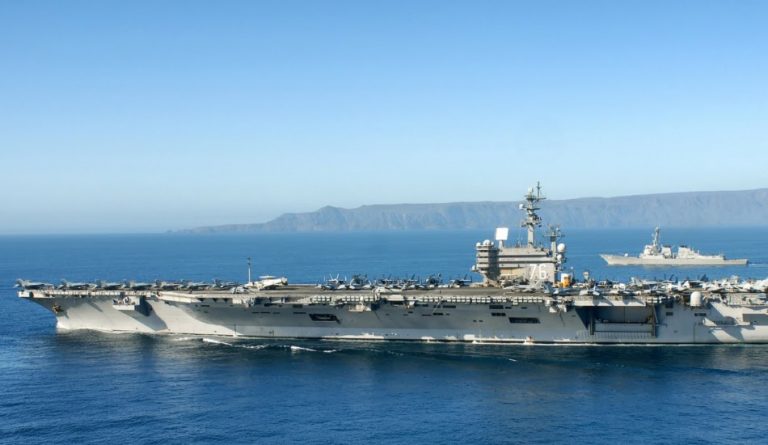Two American carriers recently carried out joint exercises in the South China Sea, a region that Beijing claims as its own territorial waters.
Exercises of Nimitz Carrier Strike Group and the Theodore Roosevelt Carrier Strike Group aimed to boost interoperability between the two and improve control and command capabilities. It is the first time since July 2020 that the United States has conducted dual-carrier operations in the South China Sea.
Chinese Foreign Ministry spokesman Wang Wenbin said that Washington sending warships and aircraft into the South China Sea is not conducive to stability and peace in the region. Labeling it a “show of force,” the ministry spokesman said that Beijing would work with other countries to maintain peace in the area.
The South China Sea region that Beijing claims to own is hotly contested. Neighboring nations also claim it. As a result, communist China has been militarizing the area aggressively in a bid to intimidate neighbors. The U.S. Navy’s joint exercises challenge Beijing’s claims and protect these nations from Chinese bullying.
“We are committed to ensuring the lawful use of the sea that all nations enjoy under international law,” Rear Admiral Jim Kirk, commander of the Nimitz Carrier Strike Group, said in a statement.

Success
You are now signed up for our newsletter
Success
Check your email to complete sign up
This joint exercise comes on the back of the USS John S McCain, sailing near Paracel Islands in the South China Sea to reaffirm freedom of navigation. The ship had previously passed through the Taiwan Strait, triggering an angry reaction from Beijing. Taiwanese President Tsai Ing-wen said that America’s freedom of navigation operation was reassuring.
South China Sea freedom of navigation
It’s not just the US sending ships into the South China Sea, challenging the Chinese communist regime’s dominance in the region. France recently sent a Rubis-class nuclear attack submarine tothe South China Sea. Armed Forces Minister Florence Parly noted that the mission aimed to affirm that “international law is the only rule that is valid,” no matter which sea they sail.
Hu Bo is the director of the Beijing-based think tank South China Sea Strategic Situation Probing Initiative. He believes that American allies are more confident about the US taking up its international obligation to keep China in check after Biden assumed power. France might want to present itself as an alternative partner to nations in the Indo-Pacific that may not align with communist China or the United States.
Last September, NATO members Germany, France, and Britain declared to the UN that they favored the 2016 International Tribunal ruling. It states that Beijing’s claims of “historic rights” over the South China Sea are invalid and incompatible with international law. Former PLA instructor Song Zhongping said that this is an enlargement of NATO.
“It will increase military pressure on China… But some [U.S. allies] have come to the region because of common values like freedom of navigation and overflight, rather than their national interests, so they’re unlikely to go all out to confront China,” he told South China Morning Post.
The UK and Japan will be holding joint exercises in the region this year. The British Royal Navy will send a strike group through the South China Sea. Similarly, Germany will send a naval frigate to the Indo-Pacific to boost its presence in the area.
Follow us on Twitter or subscribe to our email list














